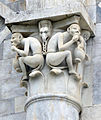The Leaning Tower of Pisa
Leaning Tower of Pisa :
In the Italian city of Pisa ,The Leaning Tower of Pisa is the freestanding bell tower or campanile of the cathedral . It also know worldwide for its nearly four-degree lean, the result of an unstable foundation.
In 1990,It may even stay upright well, almost upright forever .A few ill-advised construction projects accelerated the Leaning Tower's invisibly slow fall during the past couple of centuries and it titled 5.5 degrees , it's acutest angle ever .
The tower is situated behind the Pisa Cathedral and is the third-oldest structure in the city's Cathedral Square ,after the cathedral and the Pisa Baptistry. The Tower began to learn during construction in the 12th century , due to soft ground which could not properly support the structure's weight , and it worsened through thee completion of construction in the 14th century ,by 1990, the tilt had reached 5.5 degrees .
The weight of the tower is 14,500 metric tons (16,000 short tons).The height of the tower is 55.86 meters (183.27 feet) from the ground on the low side and 56.67 meters (185.93 feet) on the high side .The tower has 296 or 294 steps , the seventh floor has two fewer steps on the north-facing staircase .The width of the walls at the base is 2.44 m (8 feet 0.06 inch).
There is literally nothing inside the Tower ! It is just a hollow cylinder from bottom to top . But it doesn't disappoint you, the contrast between the outside and the inside is pretty cool.
The tower's famous lean started after it's foundation was built in the week in 1990 , The Leaning Tower of Pisa was closed for repairs. The problem it was leaning too much .The tower was built over a period of 200 years between 1173 and 1372 A.D.
There has been controversy about the real identity of the architect of the Leaning Tower of Pisa. For many years, the design was attributed to Guglielmo and Bonanno Pisano, a well-known 12th-century resident artist of Pisa, known for his bronze casting, particularly in the Pisa Duomo. Pisano left Pisa in 1185 for Monreale, Sicily, only to come back and die in his home town. A piece of cast bearing his name was discovered at the foot of the tower in 1820, but this may be related to the bronze door in the façade of the cathedral that was destroyed in 1595. A 2001 study seems to indicate Diotisalvi was the original architect, due to the time of construction and affinity with other Diotisalvi works, notably the bell tower of San Nicola and the Baptistery, both in Pisa.
- Total number of bells: 7, tuned to musical scale,clockwise:
- 1st bell: L'Assunta, cast in 1654 by Giovanni Pietro Orlandi, weight 3,620 kg (7,981 lb)
- 2nd bell: Il Crocifisso, cast in 1572 by Vincenzo Possenti, weight 2,462 kg (5,428 lb)
- 3rd bell: San Ranieri, cast in 1719–1721 by Giovanni Andrea Moreni, weight 1,448 kg (3,192 lb)
- 4th bell: La Terza (1st small one), cast in 1473, weight 300 kg (661 lb)
- 5th bell: La Pasquereccia or La Giustizia, cast in 1262 by Lotteringo, weight 1,014 kg (2,235 lb)
- 6th bell: Il Vespruccio (2nd small one), cast in the 14th century and again in 1501 by Nicola di Jacopo, weight 1,000 kg (2,205 lb)
- 7th bell: Dal Pozzo, cast in 1606 and again in 2004, weight 652 kg (1,437 lb)
- Number of steps to the top: 296
- Elevation of Piazza del Duomo: about 2 metres (6 feet, DMS)
- Height from the ground floor: 55.863 metres (183 ft 3.3 in),8 stories
- Height from the foundation floor: 58.36 m (191 ft 5.64 in)
- Outer diameter of base: 15.484 metres (50 ft 9.6 in)
- Inner diameter of base: 7.368 metres (24 ft 2.1 in)
- Angle of slant: 3.97 degrees or 3.9 metres (12 ft 10 in) from the vertical
- Weight: 14,700 metric tons (16,200 short tons)
- Thickness of walls at the base: 2.44 metres (8 ft 0 in) .
















🔥🔥👍👍👌👌
ReplyDelete💥💥💥💥
Delete💥💥💥💥
ReplyDelete👍👍👌👌👌👌
ReplyDelete🔥🔥🔥🤘✌️
ReplyDeleteNice Content Bro🔥🔥
ReplyDelete👍👍😊😊
ReplyDelete🔥🔥🔥
ReplyDelete♥♥
ReplyDeleteNice information man
ReplyDelete👌👌
ReplyDelete